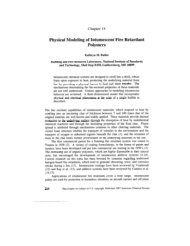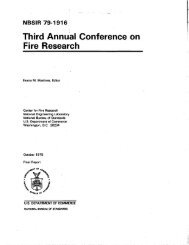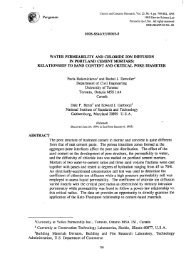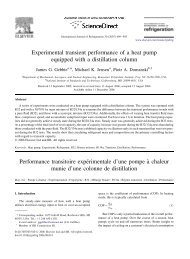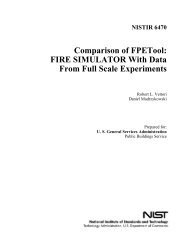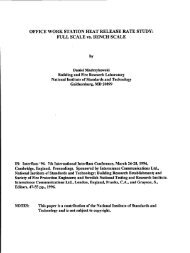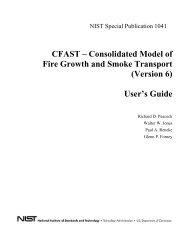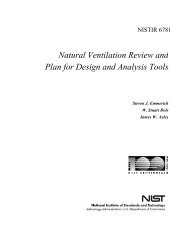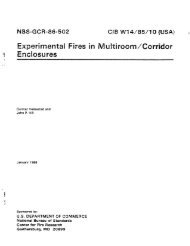Study of Technology for Detecting Pre-Ignition Conditions of ... - NIST
Study of Technology for Detecting Pre-Ignition Conditions of ... - NIST
Study of Technology for Detecting Pre-Ignition Conditions of ... - NIST
Create successful ePaper yourself
Turn your PDF publications into a flip-book with our unique Google optimized e-Paper software.
2.4.1 Experimental Operation<br />
msc-uG95-x145<br />
Each experiment began tith no heat applied to the food and ended soon after ignition <strong>of</strong><br />
the food. The duration <strong>of</strong> each test was detemined by the time to ignition which varied from<br />
about 5 to 30 minutes, but was typically about 15 minutes. The steps involved in these<br />
experiments are described in the following paragraphs.<br />
All <strong>of</strong> the power cords and strips were plugged in or switched on. The test identification<br />
and date labels were changed <strong>for</strong> photographic purposes. The pan-wall thermocouple was<br />
attached, and the pan, tiemocouple, and lid were weighed together. After the food material<br />
equilibrated to room temperature, the appropriate amount was weighed and placed in the pan.<br />
Then the -pan, food, tiemocouple, and lid were reweighed to get an accurate mass <strong>of</strong> the food.<br />
The pan was placed on the burner, and the pan handle was secured with a clamp to a heavy ring<br />
stand to prevent spillage <strong>of</strong> the food during extin~ishment with the lid. As the pan was placed<br />
on the burner, the burner-pan interface thermocouple was carefilly positioned. The lid was not<br />
put on the pan, but the lowest thermocouples <strong>of</strong> the grid were checked <strong>for</strong> potential interference<br />
when the lid would be used to extinguish the fire. The pan-wall thermocouple was plugged into<br />
its data line, and the two food tiemocouples were positioned in the food. The plume<br />
thermocouple grid was centered, and the He-Ne laser beams were turned on to check <strong>for</strong><br />
interference by the grid. Any range or range-hood thermocouples that had been previously<br />
removed were repositioned.<br />
The afterburner system and exhaust hood were turned on and allowed to equilibrate. If<br />
the test protocol called <strong>for</strong> an active range hood, it was also turned on. The data acquisition<br />
system was switched on, the program was initiated, and the required inputs were provided. The<br />
pressure transducer was switched on, and tie height and centering <strong>of</strong> the hi-directional probe were<br />
checked. The photodiode circuits were powered, and the horizontal alignment <strong>of</strong> the He-Ne<br />
lasers was adjusted. For the electric range, the current meters and power meter were turned on<br />
as was the digital vol~eter used to read the AC signals.<br />
The FTIR and its computer were operated separately from the rest <strong>of</strong> the experimental<br />
apparatus. The FTIR detector was filled with liquid nitrogen shortly be<strong>for</strong>e each test to cool the<br />
sensing element. An iterative alignment procedure was per<strong>for</strong>med on the FTB? receiver using<br />
the spectrometer s<strong>of</strong>mare. Initially the apparatus was aligned to give 90 % <strong>of</strong> the signal, but<br />
when some experiments experienced problems with flame radiation saturating the detector, it<br />
became necessary to decrease the signal alignment to roughly 8(YX0.<br />
The infrared camera also required liquid nitrogen. The camera was usually filled with<br />
nitrogen about 10 minutes be<strong>for</strong>e a test and topped-<strong>of</strong>f immediate y be<strong>for</strong>e the test to ~~arantee<br />
sufficient cooling <strong>for</strong> a test <strong>of</strong> long duration. The infrared camera and optical video cmera were<br />
both checked <strong>for</strong> need <strong>of</strong> cassette replacement. The optical video camera was focused and the<br />
date and time labels were activated. The still photography camera was checked <strong>for</strong> slide film and<br />
loaded if necessary. The initial cooking scene was usually photographed.<br />
When all <strong>of</strong> the previous activities were completed, the test was nearly ready to begin.<br />
Two zero scans were recorded with the data acquisition system and were checked <strong>for</strong> anomalies<br />
16<br />
.



